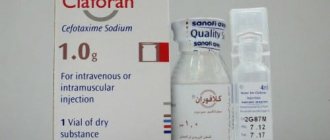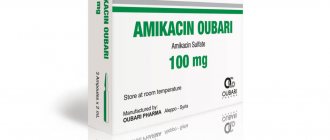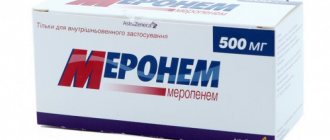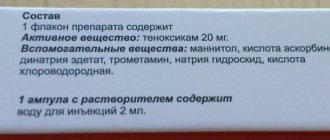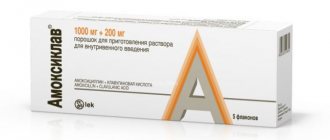Composition and release form
The drug is available in the form of a white crystalline powder for the preparation of intravenous and intramuscular injection solutions. Its active component is ceftazidime, an antibacterial substance from the group of cephalosporins. The medicine is packaged in glass bottles of different sizes, which are placed in cardboard packaging. The kit includes instructions for use of Ceftazidime. The content of the active substance in the bottles is given in the table:
| Release form | Amount of ceftazidime, mg | Excipients |
| Powder in a bottle 500 | 582,5 | anhydrous form of sodium carbonate |
| Powder in a bottle 1000 | 1165,0 | |
| Powder in a bottle 2000 | 2330,0 |
Use during pregnancy and lactation
Adequate and strictly controlled studies on the safety of the drug in pregnant women have not yet been conducted. According to animal studies, no adverse effects of the drug on the fetus were found. Taking into account that ceftazidime crosses the placenta, its use during pregnancy is allowed only in cases of extreme necessity, after a careful assessment of the balance between the expected benefit of therapy for the mother and the potential risk to the health of the fetus.
Since the drug passes into breast milk, if it is prescribed during lactation, it is recommended to stop breastfeeding.
pharmachologic effect
The antibiotic Ceftazidime is the most active among 3rd generation cephalosporins, resistant to beta-lactamases - enzymes that inhibit the action of antibacterial agents. It suppresses the synthesis of the most important component of the bacterial cell wall, which performs mechanical and protective functions - peptidoglycan, releases autolytic (self-destructing) enzymes that damage and dissolve the cell wall, and promotes the death of microorganisms.
Many strains resistant to penicillin and other antibiotics are sensitive to Ceftazidime: Haemophilus influenzae and Escherichia coli, Citrobacteria, Klebsiella, Neisseria, Proteus, Enterobacteriaceae, Morganella, Acinetobacter, Providencia, Salmonella, Serratia, Shigella, Staphylococcus, Streptococcus, Clostridia, Propionibacter AI, parainfluence, peptococci, peptostreptococci. Staphylococcus epidermalis, enterococci, chlamydia, campylobacter, streptococcus fecalis are resistant to the antibiotic.
The maximum effect is achieved 20–30 minutes after intravenous and 1 hour after intramuscular injection of Ceftazidime. The active substance penetrates into all organs and tissues, including sputum, bones, eyes, but does not penetrate well through the physiological barrier between the central nervous and circulatory systems. Easily crosses the placenta and enters breast milk. The liver does not metabolize the antibiotic. Up to 80–90% of Ceftizidime is excreted by the kidneys within 1 day, the rest is excreted in the bile.
Pharmacological properties
Pharmacodynamics
Ceftazidime is a representative of the group of third generation cephalosporins; antibacterial agent with a wide range of effects. It exhibits a bactericidal effect, inhibiting the synthesis of the cell wall of microorganisms, and is resistant to the effects of most beta-lactamases.
Ceftazidime demonstrates activity against the following microorganisms:
- Gram-negative: Klebsiella spp. (including Klebsiella pneumoniae), Pseudomonas aeruginosa, Pseudomonas spp. (including Pseudomonas pseudomallei), Proteus vulgaris, Proteus mirabilis, Proteus rettgeri, Escherichia coli, Morganella morganii, Enterobacter spp., Providencia spp., Salmonella spp., Citrobacter spp., Shigella spp., Serratia spp., Yersinia enterocolitica, Acinetobacter spp., Neisseria meningitidis, Pasteurella multocida, Neisseria gonorrhoeae, Haemophilus parainfluenzae and Haemophilus influenzae (including strains resistant to ampicillin); among third-generation cephalosporins, ceftazidime is characterized by the greatest activity against nosocomial infections and Pseudomonas aeruginosa;
- gram-positive: Streptococcus pyogenes (β-hemolytic streptococcus group A), Staphylococcus aureus (strains sensitive to methicillin), Micrococcus spp., Staphylococcus epidermidis (strains sensitive to methicillin), Streptococcus pneumoniae, Streptococcus group B (Streptococcus agalactiae), Streptococcus spp . (except Streptococcus faecalis), Streptococcus mitis;
- anaerobic bacteria: Peptostreptococcus spp., Clostridium perfringens, Peptococcus spp., Propionibacterium spp., Fusobacterium spp., Bacteroides spp. (the vast majority of Bacteroides fragilis strains are resistant).
Ceftazidime is inactive against the following microorganisms: Chlamydia spp., Clostridium difficile, Campylobacter spp., Listeria monocytogenes, Streptococcus faecalis and many other Enterococci, methicillin-resistant strains of Staphylococcus epidermidis and Staphylococcus aureus.
Pharmacokinetics
After intramuscular injections in doses of 0.5 and 1 g, the maximum concentration (Cmax) of ceftazidime in plasma is fixed after 1 hour and is 17 and 39 mg/l, respectively, with intravenous bolus administration of ceftazidime at a dose of 0.5; 1 and 2 g Cmax is observed 5 minutes after injection and is 46, 87 and 170 mg/l, respectively. Therapeutic effective concentrations of the drug in plasma remain for 8–12 hours after IM and IV administration.
The active substance of the drug binds to plasma proteins by 10–15%. Only the free fraction of ceftazidime exhibits a bactericidal effect. The plasma concentration of ceftazidime does not determine the degree of protein binding.
After intravenous administration of the drug, it is rapidly distributed in most tissues and fluids of the body. At therapeutic concentrations, the drug is detected in pleural, peritoneal, pericardial, synovial and intraocular fluids, as well as in sputum, bile and urine. Concentrations of ceftazidime exceeding the minimum inhibitory concentration (MIC) for most pathogens sensitive to the drug may be observed in the myocardium, bone tissue, bones, gallbladder and soft tissues. The active substance easily passes through the placenta and is excreted in breast milk. In the absence of inflammation in the meningeal membranes, the antibiotic does not penetrate well through the blood-brain barrier. Against the background of meningitis, concentrations of the substance in the cerebrospinal fluid reach a therapeutic level of 4–20 mg/l or more.
Ceftazidime does not undergo biotransformation in the liver. With normal renal function, the half-life (T½) of the drug reaches approximately 2 hours, with functional renal impairment - 2.2 hours. It is excreted unchanged by the kidneys through glomerular filtration and tubular secretion up to 80–90% of the administered dose over 24 hours (70% in the first 4 hours). Up to 1% of the substance is excreted with bile. In newborns, T½ of ceftazidime is 3–4 times higher than in adults.
Indications for use
Ceftazidime is intended for intensive treatment of a large number of mixed and monoinfections caused by microorganisms sensitive to the active substance, and for the prevention of the occurrence of foci of infections in the postoperative period. Indications for prescribing an antibiotic are sepsis, infected burns and wounds, hemodialysis, infections:
- epidermis and soft tissues;
- membranes of the spinal cord and brain – meningitis;
- bones and joints;
- respiratory tract – pneumonia, lung abscess, bronchitis, pleural empyema;
- urinary tract – urethritis, pyelonephritis, cystitis, kidney abscess;
- prostate gland after surgery;
- Gastrointestinal tract, abdominal organs, peritoneum - intestinal infection, peritonitis, acute cholecystitis, cholangitis;
- ENT organs – otitis media, pharyngitis, tonsillitis, tonsillitis.
Directions for use and dosage
Ceftazidime is a medicine for parenteral use; it is used bypassing the gastrointestinal tract, using injections and inhalations. The antibiotic is administered intramuscularly or intravenously, in a slow stream over 5 minutes or dropwise for 30–60 minutes. The dose for the patient is determined individually, taking into account the severity of the disease, age, weight, and kidney condition. For most infections, for children over 12 years of age and adults, Ceftazidime is indicated in an amount of 1 g at intervals of 8 or 2 g every 12 hours. In case of kidney dysfunction, the dose of the substance is reduced:
- If the infection is life-threatening, use the maximum daily dose for adults of 6 g, which is administered at 2 g intervals of 8, or 3 g every 12 hours.
- For skin lesions and uncomplicated pneumonia, 0.5-1 g is prescribed at intervals of 8 hours.
- Bone and joint infections require 2 mg intravenously at 12-hour intervals.
- For cystic fibrosis, infection of the lungs with pseudomonas, the daily dose is calculated based on body weight and is 100–150 mg/kg of body weight.
- The maintenance dose for hemodialysis and hemofiltration should be administered every 12 hours, its volume is determined taking into account the clearance of creatinine (the end product of protein metabolism). In addition to intravenous injections, the antibiotic can be administered with hemodialysis fluid.
Articles on the topic
- Omnik - instructions and mechanism of action, contraindications, side effects, dosage regimen and analogues
- Onycholysis - treatment at home according to traditional medicine recipes and medications
- Gelatin for joints - how to take a tincture or cocktail correctly, use of compresses
Ceftazidime
Active substance:
Ceftazidime*
Pharmgroup:
Cephalosporins
Average price in pharmacies
| Name | Manufacturer | average price |
| Ceftazidime 1.0 n1 vial pore d/solution i.v. i.m. | KRASFARMA | 91.00 |
Analogs for the active substance:Bestum Vicef Kefadim Orzid Tasicephus Tizim Fortazim Fortum Cefzid Ceftazidime and sodium carbonate Ceftazidime Kabi Ceftazidime sodium Ceftazidime Sandoz Ceftazidime-AKOS Ceftazidime-Jodas Ceftidine |
How to dilute Ceftazidime
A solution for intramuscular administration is prepared by mixing the powder with water for injection or 1% lidocaine solution. The resulting mixture should not contain undissolved powder crystals, but bubbles of carbon dioxide may be present, which do not affect the properties of the medicine. It is necessary to prepare a solution for intravenous infusion before administration, further diluting the mixture prepared according to the intramuscular injection scheme in 50–100 ml of the following substances:
- 0.9% sodium chloride solution
- Ringer's multicomponent saline solution;
- 5–10% glucose solution;
- a mixture of 5% glucose solution with 0.9% sodium chloride;
- 5% sodium bicarbonate solution.
Ceftazidime for children
For children under 12 years of age, the antibiotic is administered in smaller quantities, using intramuscular or intravenous injections, in 2-3 doses, based on age, weight, severity of the disease, taking into account that the maximum amount of Ceftazidime should not exceed 6 g per day. For immunodeficiency, meningitis, cystic fibrosis, the medicine can be administered to children based on the norm of 150–200 mg/kg. Depending on the child's weight, the dose of ceftazidime should vary as follows:
- in the first 2 months of life – 25–50 mg/kg;
- from 2 months to 12 years – 30–50 mg/kg;
- over 12 years – 30–100 mg/kg.
special instructions
If there is a history of allergic reactions to penicillins, cross-hypersensitivity to cephalosporins has been observed.
Ceftazidime can block the synthesis of vitamin K as a result of inhibition of intestinal flora, which in turn can lead to a decrease in the concentration of blood clotting factors dependent on this vitamin, and in some cases, provoke the appearance of hypothrombinemia and bleeding. Taking vitamin K in an appropriate dose relieves hypothrombinemia. In persons with poor nutrition, weakened and elderly patients, and in patients with impaired liver function, the risk of bleeding is aggravated.
In some patients, during drug therapy or after its completion, the appearance of pseudomembranous colitis may occur. If this complication develops, in mild cases it is enough to stop using the drug, and in severe cases, it is necessary to restore the protein and water-salt balance, prescribe metronidazole, vancomycin or bacitracin.
During the course, the use of ethanol is contraindicated due to the possible occurrence of effects similar to the effects of disulfiram (flushing, vomiting, abdominal cramps, nausea, headache, tachycardia, decreased blood pressure, shortness of breath).
Ceftazidime at concentrations of 1–40 mg/ml is compatible with the following solutions: sodium lactate solution, sodium chloride solution 0.9%, Hartmann's solution, dextrose solutions 5% and 10%, sodium chloride solution 0.225% and dextrose 5%, sodium chloride solution 0.9% or 0.45% and dextrose 5%, a solution of Dextran 40 10% or Dextran 70 6% in a solution of sodium chloride 0.9% or in a solution of dextrose 5%, a solution of sodium chloride 0.18% and dextrose 4% , metronidazole solution 5 mg/ml.
At concentrations of 0.05–0.25 mg/ml, ceftazidime is compatible with intraperitoneal dialysis solution (lactate). For intramuscular injections, Ceftazidime can be diluted with a solution of lidocaine hydrochloride 0.5% or 1%.
If ceftazidime at a concentration of 4 mg/ml is added to the following solutions, activity will be observed in both components: cefuroxime sodium 3 mg/ml in a 0.9% sodium chloride solution, hydrocortisone sodium phosphate 1 mg/ml in a 0.9% sodium chloride solution or dextrose solution 5%, cloxacillin sodium 4 mg/ml in sodium chloride solution 0.9%, potassium chloride 10 or 40 milliequivalents (mEq)/L in sodium chloride solution 0.9%, heparin 10 or 50 International Units (IU) /ml in 0.9% sodium chloride solution.
When combining a solution of ceftazidime (500 mg in 1.5 ml of water d/i) and metronidazole (500 mg/100 ml), both components retain their activity.
Impact on the ability to drive vehicles and complex mechanisms
Patients operating complex machinery and equipment should exercise caution when performing these tasks (including driving) while using Ceftazidime.
Drug interactions
The therapeutic effect of an antibiotic can be altered when taken simultaneously with other pharmaceutically incompatible drugs or when choosing the wrong solvent. Some medications reduce the clearance of ceftazidime (the rate of cleansing of body tissues) and contribute to nephrotoxic kidney damage with subsequent renal failure. The simultaneous use of an antibiotic with the following medications is not recommended:
- loop diuretics – Furosemide, Ethacrynic acid, Torsemide;
- aminoglycosides – Streptomycin, Neomycin, Kanamycin;
- tricyclic glycopeptides – Vancomycin, Teicoplanin;
- antibiotics of the lincosamide group - Clindamycin, Lincomycin;
- low molecular weight heparins - Fragmin, Klivarin, Clexane;
- sodium bicarbonate solution.
Contraindications
Ceftazidime is contraindicated for use in the presence of hypersensitivity to any of its components, as well as to other antibiotics from the group of penicillins and cephalosporins.
The antibacterial agent should be used with caution in the following diseases/conditions:
- neonatal period;
- history of bleeding;
- severe renal dysfunction;
- diseases of the gastrointestinal tract (including history, ulcerative colitis);
- malabsorption syndrome (due to the increased risk of decreased prothrombin activity, especially in the presence of severe renal and/or liver failure);
- combination with aminoglycosides and loop diuretics.
Side effects
The hematopoietic and blood coagulation systems, digestive and urinary tracts react to Ceftazidime. During therapy, allergic reactions, fungal infections, phlebitis (inflammation of the vein wall), and pain at the injection site may occur. The following side effects are often observed:
- diarrhea, vomiting, nausea;
- encephalopathy (non-inflammatory disease of the brain);
- jaundice, hepatitis, colitis, cholestasis (stagnation of bile components in the liver);
- interstitial nephritis (non-infectious inflammation of the tissues and tubules of the kidneys), toxic nephropathy;
- leukopenia, neutropenia, thrombocytopenia (decrease in the level of leukocytes, neutrophils, platelets in the blood), hemolytic anemia (destruction of red blood cells in the blood), hypoprothrombinemia (clotting factor deficiency);
- lymphocytosis, thrombocytosis, eosinophilia (increased number of lymphocytes, platelets, eosinophils in the blood), hyperbilirubinemia (increased bilirubin levels);
- hypercreatininemia (increased creatine level), high urea concentration;
- hemorrhage (bleeding);
- skin itching, urticaria, bronchospasm, fever, Quincke's edema, Lyell's syndrome (bullous lesions of the entire skin and mucous membranes);
- candidal stomatitis, vaginitis.
Overdose
Symptoms of an overdose of Ceftazidime may be: dizziness, headache, paresthesia, abnormal laboratory test results (hyperbilirubinemia, hypercreatininemia, leukopenia, thrombocytosis, eosinophilia, thrombocytopenia, prolongation of prothrombin time), encephalopathy, convulsions, coma.
For this condition, symptomatic and supportive treatment is carried out; a specific antidote is unknown. In case of unsuccessful conservative therapy in case of severe overdose, the level of the drug in the blood may be reduced during hemodialysis.
Analogs
Antibacterial agents, similar in pharmaceutical action to Cefrazidime, are produced on the basis of active substances of the cephalosporin series - cefrazidime, ceftriaxone, cefoperazone, cefotaxime. Synonyms of the drug are produced in the form of a powder for the preparation of an injection solution, used parenterally.
- Loraxone (Iran) – powder based on ceftriaxone. It is characterized by a high speed of achieving the maximum amount of the active component in the blood plasma - 30-45 minutes with intramuscular administration, 5-10 with intravenous administration. Effective in the treatment of inflammatory diseases of the meninges.
- Medaxone (Cyprus) is an antibiotic in powder form containing ceftriaxone. Effective against many bacteria resistant to other antibiotics - penicillin, aminoglycosides, etc. Medaxon's effectiveness against primary and secondary syphilis has been clinically proven.
- Cefoperazone (Russia) is a 3rd generation antibiotic based on cefoperazone. Salmonella, Shigella, Fusobacteria, Eubacteria, etc. are sensitive to the drug. It is successfully used to prevent complications after cardiovascular, gynecological, and orthopedic operations.
- Cefotaxime (Russia) is a semi-synthetic bactericidal drug based on cefotaxime. Indicated for peritonitis, sepsis, gonorrhea, Lyme disease caused by a tick bite. It is distinguished by long-term – up to 12 hours – preservation of bactericidal concentration in the blood.
- Ceftriaxone (Belarus) is an antibiotic containing ceftriaxone, effective against gonococcus, meningococcus, Escherichia coli, Pseudomonas aeruginosa, etc. It is successfully used in the treatment of infections of the urogenital area, including pyelonephritis, typhoid fever, salmonellosis.
Instructions:
Clinical and pharmacological group
06.010 (III generation cephalosporin)
Release form, composition and packaging
The powder for the preparation of injection solution is crystalline, from white to cream color.
| 1 fl. | |
| ceftazidime | 1 g |
Excipients: sodium carbonate.
Bottles (1) - cardboard packs.
The powder for the preparation of injection solution is crystalline, from white to cream color.
| 1 fl. | |
| ceftazidime | 2 g |
Excipients: sodium carbonate.
Bottles (1) - cardboard packs.
The powder for the preparation of injection solution is crystalline, from white to cream color.
| 1 fl. | |
| ceftazidime | 250 mg |
Excipients: sodium carbonate.
Bottles (1) - cardboard packs.
The powder for the preparation of injection solution is crystalline, from white to cream color.
| 1 fl. | |
| ceftazidime | 500 mg |
Excipients: sodium carbonate.
Bottles (1) - cardboard packs.
pharmachologic effect
Antibiotic from the group of third generation cephalosporins. It has a wide spectrum and has a bactericidal effect, disrupting the synthesis of the cell wall of microorganisms. Resistant to most β-lactamases.
The drug is active against gram-negative microorganisms: Haemophillus influenzae, Neisseria spp. (including Neisseria gonorrhoeae), Citrobacter spp., Enterobacter spp., Escherichia coli, Klebsiella spp. (including Klebsiella pneumoniae), Morganella spp. (including Morganella morganii), Proteus spp. (including Proteus mirabilis /indole-positive strains/, Proteus vulgaris), Providensia spp. (including Providensia rettgeri), Serratia spp., Acinetobacter spp., Haemophillus parainfluenzae (including strains resistant to ampicillin), Pasteurella multocida, Salmonella spp., Shigella spp., Yersinia enterocolitica.
Ceftazidime has the highest activity among third-generation cephalosporins against Pseudomonas aeruginosa and nosocomial infections.
The drug is active against gram-positive bacteria: Micrococcus spp., Streptococcus spp. (including Streptococcus aureus, Streptococcus mitis, Streptococcus pneumoniae, Streptococcus pyogenes group A, Streptococcus viridans /excluding Streptococcus faecalis/), methicillin-sensitive strains of Staphylococcus aureus, Staphylococcus epidermidis.
Ceftazidime is active against anaerobic bacteria: Bacteroides spp. (most strains of Bacterioides fragilis are resistant), Clostridium perfingens, Peptococcus spp., Peptostreptococcus spp., Propionibacterium spp.
The drug is not active against methicillin-resistant strains of Staphylococcus aureus, Staphylococcus epidermidis, Streptococcus faecalis, Campylobacter spp., Chlamydia spp., Clostridium difficile, Enterococcus spp., Listeria spp. (including Listeria monocytogenes).
Pharmacokinetics
Suction
After intramuscular administration in doses of 0.5 g and 1 g, Cmax in blood plasma is 17 µg/l and 39 mg/l, respectively, Tmax is 1 hour. Cmax after intravenous administration in doses of 0.5 or 1 g is 42 µg/l and 69 mcg/l, respectively, and is achieved by the end of the infusion. The drug concentration of 4 mcg/ml is maintained for 6-8 hours. Therapeutic serum concentrations are maintained for 8-12 hours.
Distribution
Plasma protein binding is reversible and is less than 15%. Only the free fraction of ceftazidime has a bactericidal effect. The degree of binding to plasma proteins does not depend on concentration.
After intravenous administration, it is quickly distributed in the human body and reaches therapeutic concentrations in most tissues and body fluids, incl. in synovial, pericardial and peritoneal fluids, as well as in bile, sputum and urine. Distribution also occurs in the bones, myocardium, gall bladder, skin and soft tissues in concentrations sufficient to treat infectious diseases, especially in inflammatory processes that enhance the diffusion of the drug. It penetrates poorly through the intact BBB. With meningitis, the concentration in the cerebrospinal fluid reaches therapeutic levels.
Vd is 0.21-0.28 l/kg.
The drug accumulates in soft tissues, kidneys, lungs, bones, joints, and serous cavities.
Metabolism
The drug is not metabolized in the liver.
Removal
T1/2 with normal renal function is 1.8 hours. Excreted by the kidneys up to 80-90% (70% of the administered dose is excreted in the first 4 hours) unchanged by glomerular filtration and tubular secretion equally within 24 hours.
Pharmacokinetics in special clinical situations
T1/2 for renal impairment – 2.2 hours.
Impaired liver function does not affect the pharmacodynamics and pharmacokinetics of the drug (no dose adjustment is required).
Dosage
The drug Ceftazidime is used only parenterally. The dose of the drug is set individually, taking into account the severity of the disease, the location of the infection and the sensitivity of the pathogen, age and body weight, and renal function.
After diluting the contents of the bottle, the drug is administered intramuscularly (should be injected into large muscles) or intravenously (stream or drip), 500 mg - 2 g every 8 - 12 hours. For most infections, a dose of 1 g every 8 hours or 2 hours is effective. g every 12 hours. In immunocompromised patients, including patients with neutropenia and severe disease, Ceftazidime should be prescribed 2 g every 8 or 12 hours.
Adults and teenagers
Complicated urinary tract infections - IM or IV 0.5-1 g every 8-12 hours.
Uncomplicated pneumonia and skin infections - IM or IV 0.5-1 g every 8 hours.
Cystic fibrosis, lung infections caused by Pseudomonas spp. - from 100 to 150 mg / kg /, frequency of administration - 3 times / day (use of a dose of up to 9 g / in such patients did not cause complications).
Infections of bones and joints - 2 g intravenously every 12 hours.
For extremely severe or life-threatening infections - 2 g IV every 8 hours.
After an initial loading dose of 1 g, adults with renal impairment (including patients undergoing dialysis) may require a dose reduction as follows:
| Creatinine clearance | Dose |
| > 50 ml/min (0.83 ml/sec) | usual doses for adults and adolescents |
| 35-50 ml/min (0.52-0.83 ml/sec) | 1 g every 12 hours |
| 16-30 ml/min (0.27-0.50 ml/sec) | 1 g every 24 hours |
| 6-15 ml/min (0.10-0.25 ml/sec) | 500 mg every 24 hours |
| < 5 ml/min (0.08 ml/sec) | 500 mg every 48 hours |
| Patients undergoing hemodialysis | 1 g after each hemodialysis session |
| Patients undergoing peritoneal dialysis | 500 mg every 24 hours |
These figures are indicative. In such patients, it is recommended to monitor serum drug levels, which should not exceed 40 mg/l.
T1/2 of the drug during hemodialysis is 3-5 hours. The appropriate dose of the drug should be repeated after each dialysis period.
For peritoneal dialysis, Ceftazidime can be included in the dialysis fluid at a dose of 125 mg to 250 mg per 2 liters of dialysis fluid.
Children
Children under 1 month of age - intravenous infusion at a dose of 30 mg/kg/day (frequency of administration: 2).
Children aged 2 months to 12 years – intravenous infusion at a dose of 30-50 mg/kg/day (frequency of administration 3).
For children with reduced immunity, cystic fibrosis, or meningitis, the drug is prescribed at a dose of up to 150 mg/kg/day every 12 hours.
The maximum daily dose for children should not exceed 6 g.
Rules for the preparation of solutions for parenteral administration
1. Primary breeding
| Dose | Volume of solvent for intramuscular administration | Volume of solvent for intravenous administration |
| 250 mg | 1.5 ml water for injection, 1% lidocaine hydrochloride solution (without epinephrine). | 5 ml water for injection |
| 500 mg | 1.5 ml water for injection | 5 ml water for injection |
| 1 g | 3 ml water for injection | 10 ml water for injection |
| 2 g | 3 ml water for injection | 10 ml water for injection |
2. Secondary dilution
For intravenous drip administration, the drug solution obtained as described above is additionally diluted in 50-100 ml of one of the following solvents intended for intravenous administration: 0.9% sodium chloride solution; Ringer's solution; lactated Ringer's solution; 5%, 10% glucose solution (dextrose); 5% glucose (dextrose) solution with 0.9% sodium chloride solution, 5% sodium bicarbonate solution.
During dilution, bottles with the drug must be shaken vigorously until their contents are completely dissolved.
Before administering the solution, you should visually ensure that there are no foreign particles or sediment and that the color of the drug for parenteral administration has not changed. The color of solutions can vary from light yellow to amber, depending on the solvent and volume.
Use only freshly prepared solution!
Overdose
Symptoms: administration of inappropriately high doses of the drug Ceftazidime can cause dizziness, paresthesia, headache, seizures, and abnormal laboratory test results.
Treatment: Since there is no specific antidote, treatment of cephalosporin antibiotic overdose is symptomatic and supportive. In case of severe overdose, when conservative therapy is unsuccessful, the concentration of the drug in the blood can be reduced using hemodialysis.
Removal of the drug during dialysis: a) peritoneal - complete removal; b) hemodialysis - complete elimination.
Drug interactions
Mixing beta-lactam antibiotics (penillins or cephalosporins) with aminoglycoside antibiotics can lead to significant mutual inactivation. When prescribed simultaneously, the drugs must be administered to different parts of the body.
Mixing a solution of Ceftazidime in one syringe or in one of any containers (bottle, plastic bag) intended for intravenous administration with these antibiotics is not allowed.
Vancomycin is incompatible with Ceftazidime and, depending on the concentration, a precipitate may form. If there is a need to administer these two drugs through one tube, then it is necessary to flush the system (or device) for intravenous administration between their administrations.
When cephalosporin antibiotics are co-administered with nephrotoxic drugs, for example, loop diuretics (furosemide), there is a risk of increased nephrotoxicity, especially in patients with impaired renal function.
Use during pregnancy and lactation
To date, a sufficient number of adequate and strictly controlled studies on this drug in pregnant women have not been conducted. Animal reproduction studies did not reveal a risk of adverse effects on the fetus.
However, as is the case with most other cephalosporins that cross the placenta, extreme caution must be taken when prescribing this drug to pregnant women. If there is still a need for such a prescription, then it is necessary to carefully weigh the ratio of the possible risk to the fetus and the benefit to the mother from treatment with this drug of some serious diseases and such conditions when there is a threat to the life of the mother, or when, for some reason, therapy with other drugs unavailable or ineffective.
Ceftazidime passes into breast milk in low concentrations and no complications have been reported to date, although breastfeeding should be avoided or, as with use during pregnancy, extreme caution should be taken when administering it during breastfeeding. .
Side effects
The following side or adverse effects require special attention from doctors. Possible signs and symptoms are indicated in parentheses.
Less common or rare: hypothrombinemia (unusual bleeding or hemorrhage), pseudomembranous colitis (severe cramps and pain in the abdomen or stomach area; tenderness of the abdominal wall on palpation; severe diarrhea with watery stools; bloody diarrhea is also possible; elevated temperature).
Basic principles of treatment - see the section “Overdose”.
Rare: allergic reactions, especially anaphylaxis (bronchospasm, hypotension, fever, skin rash, itching, redness or swelling), erythema multiforme or Steven-Johnson syndrome (blistering, peeling or peeling of skin and mucous membranes; possible damage to eyes or other organs and systems), autoimmune drug-induced hemolytic anemia (unusual fatigue or weakness, yellowing of the sclera or skin), impaired renal function (decreased amount of urine or weakened concentrating ability of the kidneys), seizures (observed especially with high dosages and in patients with impaired renal function ), phlebitis or thrombophlebitis (pain, redness and swelling at the injection site).
More often or less often: oral candidiasis, candidal stomatitis (pain in the oral mucosa, gums or tongue), gastrointestinal reactions (mild diarrhea, abdominal cramps, nausea or vomiting, anorexia), vaginal candidiasis (vaginal itching and presence of discharge), transient increase in the activity of liver transaminases and alkaline phosphatase, transient hepatitis, cholestatic jaundice, headaches, dizziness, paresthesia, vaginitis, genital and anal itching.
Storage conditions and periods
Vials with undiluted Ceftazidime powder should be stored in a cool and dark place, out of reach of children, away from direct sunlight and other sources of heat, moisture and dust. Shelf life: 2 years.
Indications
The drug Ceftazidime is prescribed to adults and children for the treatment of the following infectious diseases caused by microorganisms sensitive to the drug:
- meningitis;
- sepsis (septicemia);
- severe purulent-septic conditions;
- arthritis, osteomyelitis, bursitis;
- acute and chronic bronchitis, infected bronchiectasis, pneumonia caused by gram-negative bacteria, lung abscess, pleural empyema;
- acute and chronic pyelonephritis, pyelitis, prostatitis, cystitis, bacterial urethritis, kidney abscess;
- mastitis, wound infections, trophic ulcers, phlegmon, erysipelas, infected burns;
- peritonitis, enterocolitis, retroperitoneal abscesses, diverticulitis, cholecystitis, cholangitis, gallbladder empyema;
- inflammation of the pelvic organs;
- infections of the female genital organs;
- otitis media, sinusitis, mastoiditis;
- gonorrhea (especially with hypersensitivity to antibacterial drugs from the penicillin group).
Contraindications
- hypersensitivity to other cephalosporins and penicillins.
special instructions
If it is necessary to use the drug, the benefit-risk ratio should be carefully weighed in patients with a history of bleeding, gastrointestinal diseases, especially ulcerative colitis.
In patients with a history of penicillin allergy, cross-hypersensitivity to cephalosporins was observed in 3-7% of patients. Although many patients with penicillin allergy manifesting as rash can use cephalosporins without adverse effects, caution is advised when prescribing ceftazidime.
Ceftazidime may interfere with the synthesis of vitamin K due to suppression of intestinal flora, which may cause a decrease in the levels of vitamin K-dependent clotting factors, and in rare cases lead to hypothrombinemia and bleeding. Administration of vitamin K quickly eliminates hypothrombinemia.
In severely ill, elderly and debilitated patients, in patients with impaired liver function and in people with poor nutrition, the risk of bleeding is highest.
Long-term use of the drug Ceftazidime may lead to increased growth of microorganisms insensitive to cephalosporins. If superinfection develops during treatment, appropriate measures must be taken.
Some patients may develop pseudomembranous colitis caused by Clostridium difficile toxin during or after use of ceftazidime. In mild cases, discontinuation of the drug is sufficient, and in more severe cases, restoration of water-salt and protein balance is recommended; metronidazole, bacitracin or vancomycin are prescribed.
Impact on diagnostic tests
- Coombs reaction (antiglobulin test) - in patients receiving high doses of cephalosporin antibiotics, the reaction is often positive. Rare cases of hemolysis have been reported. In newborns whose mothers received cephalosporin antibiotics before birth, the reaction may also be positive;
- prothrombin time may increase. Cephalosporin antibiotics can inhibit the synthesis of vitamin K due to suppression of intestinal flora. Patients who are critically ill, malnourished, or have impaired liver function are at greatest risk of bleeding.
Effect on laboratory tests
There may be an increase in the activity of ALT, alkaline phosphatase, AST in the blood serum, an increase in the content of bilirubin, lactate dehydrogenase, urea nitrogen, and creatinine. In rare cases, transient leukopenia, neutropenia, agranulocytosis, thrombocytopenia, eosinophilia, lymphocytosis or thrombocytosis have been observed.
Use in pediatrics
If it is necessary to use the drug in newborns and children under 1 month of age, the benefit-risk ratio of therapy should be carefully weighed.
Use for renal impairment
After an initial loading dose of 1 g, adults with renal impairment (including patients undergoing dialysis) may require a dose reduction as follows:
| Creatinine clearance | Dose |
| > 50 ml/min (0.83 ml/sec) | usual doses for adults and adolescents |
| 35-50 ml/min (0.52-0.83 ml/sec) | 1 g every 12 hours |
| 16-30 ml/min (0.27-0.50 ml/sec) | 1 g every 24 hours |
| 6-15 ml/min (0.10-0.25 ml/sec) | 500 mg every 24 hours |
| < 5 ml/min (0.08 ml/sec) | 500 mg every 48 hours |
| Patients undergoing hemodialysis | 1 g after each hemodialysis session |
| Patients undergoing peritoneal dialysis | 500 mg every 24 hours |
These figures are indicative. In such patients, it is recommended to monitor serum drug levels, which should not exceed 40 mg/l.
T1/2 of the drug during hemodialysis is 3-5 hours. The appropriate dose of the drug should be repeated after each dialysis period.
Conditions for dispensing from pharmacies
The drug is available with a prescription.
Ceftazidime price
Considering the specific nature of taking antibacterial agents, the cost of a course of treatment with Ceftazidime can be called high: with an average price of 1 bottle of 85 rubles. it is approximately 2.5 thousand rubles. An antibiotic produced by a Russian pharmaceutical company is presented in pharmacies in the Moscow region with a significant difference in cost. Ceftazidime price range:
| Name | price, rub. | Where can I buy |
| Ceftazidime 1.0 powder for solution for intravenous and intramuscular administration, bottle No. 1, Russia | 98,6 | Apteka.ru |
| 75,0 | Pharmacy "Apteki Stolichki", metro station. Shchelkovskaya, 9th Parkovaya St., 61a | |
| 80,5 | Pharmacy “Be Healthy!”, Airport metro station, Chasovaya St., 11 | |
| 99,0 | Piluli.ru | |
| 69,5 | Pharmacy "Zhivika", metro station Babushkinskaya, Shokalsky St., 2 |
Reviews of Ceftazidime
The few reviews about Ceftazidime are quite mixed. Some patients characterize the drug as a serious and strong antibacterial agent, which completely suited them and demonstrated high effectiveness in the treatment of an infectious disease. Others believe that the drug did not help them get rid of the disease and at the same time caused a number of severe adverse reactions. In this case, the lack of a positive result during treatment may be due to the insensitivity of the pathogen to the action of this antibiotic, since the latter cannot always be accurately determined without special studies. Some patients recommend using a 1% lidocaine solution as a solvent, which provides an analgesic effect, to reduce the pain of intramuscular injections of the drug.
